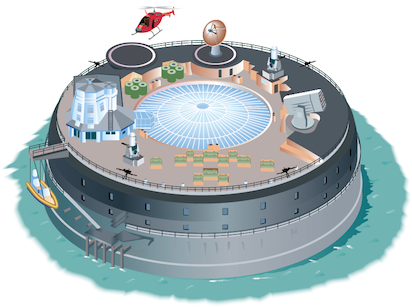No Man’s Land Fort was built in the 1860’s off the coast of Portsmouth, England. Originally constructed to defend against French invaders, it has now been converted into a luxury hotel with more than 20 rooms, two helipads and a heated indoor swimming pool. The fort is about a mile from the mainland and rises over 60 feet above the sea. At today’s prices, it would cost around £150m to build.
Whilst no one site could ever be said to be the perfect zombie-proof location, this fort comes close and with an additional expenditure of around £25m, it could be transformed into the zombie-proof fortress below. Remember, you may be able to source a similar primary site wherever you are in the world and several zombie-fighting groups are looking at ‘crowd funding’ their own perfect zombie hideouts. You will need a good sized site with obvious zombie-proofing potential, but it need not be a purpose-designed fortification. It could be an old factory with a particularly strong exterior fence, or an isolated hotel with plenty of space for growing your own crops. What is shown here is simply an example of what can be achieved.
Investing in the creation of an ideal anti-zombie fortress will doubtless cost millions. It doesn’t matter if you buy some isolated plot of land in the Australian outback or convert a historic sea fort – you will require substantial financial resources to complete a grand plan like this. Many sites will come as a shell in terms of zombie defence, meaning that you will need to add on the costs of improving the site as well as the initial purchase.
However, it is possible to join forces with other zombie survivalists and ‘crowd fund’ a defensive site. This means developing a group of friends or family who commit resources to a central fund and this is then used to create your zombie outbreak hideaway. You can find out more about these funds on many of the zombie survival forums on the internet. One group of survivalists in Glasgow has already purchased an island off the West Coast of Scotland and is currently constructing a village of ten homes with a surrounding steel fence. The group also has a boat in Glasgow which they plan to use as part of their Bug-Out plan. It will shuttle to and from the port taking survivors to their long-term settlement location. At least that’s the theory!
A survey by Survivor Magazine revealed that whilst 78% of respondents who had a prepared long-term location felt they have detailed plans on how to reach their secure basis in crisis, less than 23% had any real plan on what they were going to do as the weeks of isolation dragged on. Few were able to answer the underlying question – ‘what’s the long-term plan once you reach your fortress?’ Family members and fellow survivors will start to ask what the plan is and how long you can last. You may not have all the answers but you need to have a ‘survival narrative’ which provides them with some level of response and you need to be consistent in this area.
-
‘Once we are in our secure fortress, we will run silent for the first month of the crisis. This time will be about stock taking, securing our position and seeing out the initial chaos of the outbreak.’
Be firm here, don’t be pressured into moving too fast – there will be countless rumours of safe zones and many of these will be just rumours. Ensure that the group understands the danger of being ‘out on the road’.
-
‘After this period, we will review the situation and consider sending out fact-finding patrols or scouts if it’s safe to do so. You may be able to monitor emergency broadcasts and get this information.’
Be sure that you do not alert other desperate survivors to your safe location unless you have the resources to take more people in.
-
‘Our long-term plan is to stay secure in the bunker for at least 90 days and to review longer term options during this period. If we can expand our current location then we may use it as a long-term settlement location. If not, we will consider one of the alpha sites already identified.’
Again, be clear and decisive on this. Fellow survivors will raise all sorts of crazy ideas which will almost certainly involve your group heading off in bandit country on a fool’s errand.
Build your survival narrative around these kinds of statements. Survivors will be scared enough as it is so any degree of security you can provide will be welcome. Remember, you may not have all the answers, you may not even believe 100% in what you’re saying but as a leader you will need to stay strong and adapt as required.

